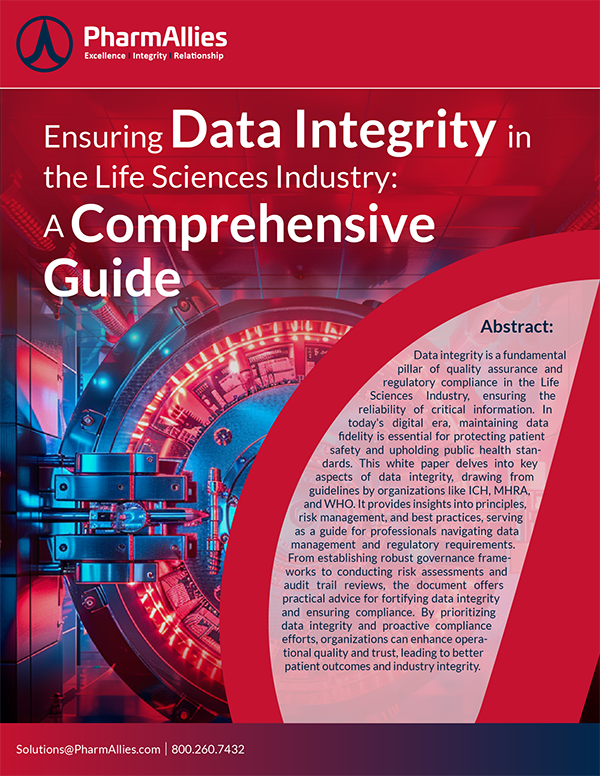Data Integrity Implementation Strategy
Introduction
Data integrity is paramount in the life sciences industry, serving as the bedrock for drug discovery, clinical trials, and biotechnological innovation. It is essential for ensuring that all data generated and analyzed are accurate, complete, and reliable, directly impacting regulatory compliance, market success, and patient safety. Upholding the highest standards of data integrity isn’t just about meeting regulatory requirements; it’s about maintaining the trust and confidence of patients and the scientific community.
As Life Science professionals, we adhere to the ALCOA principles—Attributable, Legible, Contemporaneous, Original, and Accurate—guidelines designed to safeguard the integrity of data throughout its lifecycle. Despite these standards, we in the life sciences sector face significant challenges such as technological complexities, human errors (the most commonly cited on the manufactory and packaging floor deviations), and potential data falsification, which can undermine public trust and patient care. These breaches highlight the urgent need for robust data integrity measures that can withstand the challenges posed by an increasingly digital and data-driven landscape.
This article provides strategic recommendations for reinforcing data integrity in the life sciences, exploring innovative technological solutions, stringent policy reforms, and the pivotal role of a strong ethical culture within organizations. By exploring these areas, we aim to equip life sciences professionals with effective tools and insights to enhance data integrity practices, ensuring that their work not only complies with but exceeds global regulatory standards. Through these efforts, we can promote a culture of excellence and trust, pivotal for advancing patient care and therapeutic innovation.
Initial Assessment and Stakeholder Engagement
-
Initial Assessment: Begin by conducting a detailed evaluation of the existing data management practices to pinpoint weaknesses and areas for improvement. This assessment should cover all stages of the data lifecycle—from data creation and storage to its ultimate disposal. Utilize both internal audits and, if possible, external reviews to gain a clear picture of the current state.
-
Stakeholder Engagement: Involve stakeholders from various departments—IT, clinical, regulatory, quality assurance, and others—in the initial assessment phase. This cross-functional team should work collaboratively to provide insights and identify specific needs and risks associated with their respective areas. Engaging stakeholders early ensures broader buy-in and support, which is crucial for the successful implementation of any new framework.
-
Setting Clear Objectives: Once the assessment is complete, work with the engaged stakeholders to set clear, actionable objectives for the data integrity framework. These objectives should be specific, measurable, achievable, relevant, and time-bound (SMART). They might include reducing data errors by a certain percentage, implementing new compliance measures within a set timeframe, or achieving specific regulatory data management milestones.
Development of the Framework
Based on the initial assessment results and the objectives set, design a comprehensive data integrity framework that includes the following, at minimum.
-
Standard Operating Procedures (SOPs): SOPs for all processes that involve data handling.
-
Security Measures: Define the security protocols and technologies that will protect data from unauthorized access and breaches.
-
Data Quality Measures: Implement procedures to ensure data accuracy and validation at every step of the data lifecycle.
-
Implementation Plan: Develop a phased implementation plan that prioritizes areas with the highest risk or weakest controls. This plan should detail the resources required, timelines, and responsible parties. It should also include contingency plans for potential challenges during the rollout phase.
Continuous Monitoring and Regular Updates
-
Monitoring Tools: Deploy advanced monitoring tools that can automatically track and report deviations from established data integrity guidelines. These tools should offer real-time monitoring capabilities to allow for immediate corrective actions.
-
Feedback Loop: Establish a feedback mechanism to continually gather input from users of the data integrity system. This feedback is vital for understanding the practical challenges faced by employees and for assessing the effectiveness of the current framework.
-
Regular Updates: Regularly review and update the framework to incorporate new technological advancements, changes in regulatory standards, and insights gained from ongoing monitoring and feedback. Organize quarterly review meetings with key stakeholders to discuss the effectiveness of the framework and any needed changes.
Training and Documentation
Implement comprehensive training programs to ensure that all employees understand the data integrity framework and their specific responsibilities. These training sessions should be regular and updated frequently to reflect any changes in the framework or operational practices.
-
Interactive Training Modules: Develop interactive online training modules that include simulations and scenarios specific to typical data integrity challenges in life sciences.
-
Regular Knowledge Assessments: Conduct regular assessments to measure employee understanding and retention of data integrity protocols, adjusting training content as necessary based on results.
-
Expert-Led Sessions: Host regular workshops led by experts in data integrity and regulatory compliance to keep staff updated on the latest trends and technologies.
-
Collaborative Problem-Solving Workshops: Organize workshops that allow employees to work collaboratively on hypothetical data integrity challenges, fostering a proactive approach to problem-solving.
-
Professional Certification in Data Management: Offer opportunities for key personnel to obtain professional certification in data management and integrity, recognizing their expertise and commitment to upholding industry standards.
Documentation: Keep detailed documentation of all procedures, audits, training, and updates to the framework. This documentation is crucial not only for internal records and ongoing management but also for demonstrating compliance with regulatory requirements.
Data Governance Policies
-
Clear Definition of Data Stewardship: Establish clear roles and responsibilities for data governance, defining who is accountable for data quality and integrity at each stage of the data lifecycle.
-
Data Quality Benchmarks: Set and enforce strict data quality benchmarks that must be met before data can be used in decision-making processes.
Routine Audits and Compliance Reviews
-
Third-Party Audits: Schedule regular audits by external agencies to ensure an unbiased review of data practices and compliance with both internal policies and external regulations.
-
Compliance Dashboard: Develop a real-time dashboard that provides a snapshot of compliance levels across different departments, highlighting areas of concern and prompting timely interventions.
Access Control Measures
-
Role-Based Access Control (RBAC): Implement RBAC to ensure that individuals have access only to the data necessary for their roles, minimizing the risk of unauthorized data exposure or manipulation.
-
Multi-Factor Authentication (MFA): Enhance security protocols by requiring MFA for accessing sensitive data systems, adding an additional layer of protection against unauthorized access.
Conclusion
In conclusion, the strategic implementation of a robust data integrity framework within the life sciences sector is not merely a compliance requirement but a fundamental cornerstone for advancing patient care and therapeutic innovation. Through detailed initial assessments, stakeholder engagement, and the setting of clear, actionable objectives, organizations can build a solid foundation that addresses the unique challenges and complexities of managing data in this critical field.
As we have explored, the development of comprehensive standard operating procedures, stringent security measures, and proactive data quality controls forms the backbone of a reliable data integrity framework. Coupled with a phased implementation plan, continuous monitoring, and regular updates, these steps ensure that data integrity is maintained throughout the data lifecycle, adapting to new challenges and technologies as they arise.
Furthermore, the pivotal role of training cannot be overstressed. By investing in extensive training programs, interactive learning modules, and collaborative problem-solving workshops, organizations empower their employees with the knowledge and skills needed to uphold the highest standards of data integrity. Such educational initiatives not only enhance individual competencies but also foster a proactive culture of integrity and compliance across the entire organization.
Additionally, the implementation of rigorous policy and procedural reforms, including clear data governance policies and routine compliance audits, ensures that data integrity is woven into the fabric of organizational practices. These measures, supported by advanced access control systems and multi-factor authentication, safeguard sensitive data against unauthorized access and potential breaches, thus protecting the integrity of critical information.
The commitment to maintaining stringent data integrity standards is a testament to an organization’s dedication to excellence and ethical responsibility. By embracing these strategies, life sciences companies not only comply with regulatory demands but also gain a competitive edge in the market, drive innovation, and most importantly, earn the trust of patients and the public. Ultimately, the rigorous pursuit of data integrity is essential for delivering safe, effective, and groundbreaking therapies that can transform lives.
This approach to reinforcing data integrity ensures that life sciences professionals and organizations are equipped to face future challenges with confidence, continuously pushing the boundaries of what is possible in medical science and patient care.



